Citroen DS5 2016 1.G Owner's Manual
Manufacturer: CITROEN, Model Year: 2016, Model line: DS5, Model: Citroen DS5 2016 1.GPages: 500, PDF Size: 55.11 MB
Page 101 of 500

99
DS5_en_Chap04_conduite_ed02-2015
When towing
distribution of loads
F Distribute the load in the trailer so that the
heaviest items are as close as possible to
the axle and the nose weight approaches
the maximum permitted without
exceeding
i
t.
Air density decreases with altitude, thus
reducing engine per formance. Above
1
0
00
m
etres, the maximum towed load must
be reduced by 10
% f
or every 1
0
00 metres of
altitude.
Side wind
F Take into account the increased sensitivity
t o side wind.
cooling
Towing a trailer on a slope increases the
temperature of the coolant.
As the fan is electrically controlled, its cooling
capacity is not dependent on the engine speed.
F
To l
ower the engine speed, reduce your
speed.
The maximum towed load on a long incline
depends on the gradient and the ambient
temperature.
In all cases, keep a check on the coolant
temperature.
F
If t
he warning lamp and the
STOP warning lamp come on,
stop the vehicle and switch off
the engine as soon as possible.
Braking
Towing a trailer increases the braking distance.
To avoid overheating of the brakes, the use of
engine braking is recommended.
Ty r e s
F Check the tyre pressures of the towing
v ehicle and of the trailer, observing the
recommended pressures.
Lighting
F Check the electrical lighting and signalling
o n the trailer and the hadlamp beam height
of your vehicle.
For more information on adjusting the
headlamp beam height, refer to the
corresponding section.
For more information on weights (and the
towed loads which apply to your vehicle) refer
to the corresponding section.
The rear parking sensors will be
deactivated automatically if a genuine
CITROËN towbar is used.
driving
Page 102 of 500

DS5_en_Chap04_conduite_ed02-2015
Starting / Switching off the engine
F Insert the electronic key in the reader.
F Pr ess the brake pedal for vehicles with an
automatic gearbox, or fully declutch for
vehicles with a manual gearbox.
Starting using the
electronic key Starting with Keyless Entry
and Starting
If one of the starting conditions is not met, a
reminder message appears in the instrument
panel screen. In some circumstances, it is
necessary to turn the steering wheel slightly
while pressing the "
START/STOP" button to
assist unlocking of the steering; a message
warns you when this is needed.
With a manual gearbox , put the gear lever into neutral.
With an automatic gearbox , place the gear selector at position P or N .
diesel vehicles
It is not necessary to place the electronic key in
the reader.
F
Wi
th the electronic key inside the vehicle,
press the brake pedal for vehicles with an
automatic gearbox, or fully depress the
clutch pedal for vehicles with a manual
gearbox.
F
Pr
ess the " START/STOP " button
while maintaining pressure on
the pedal until the engine starts. F
Pr
ess the "START/STOP " button
while maintaining pressure on
the pedal until the engine starts. The "Keyless Entry and Starting"
electronic key must be in the
recognition zone.
For safety reasons, do not leave this
zone with the vehicle running.
If the electronic key is not detected
in the recognition zone, a message
is displayed. Move the electronic key
into the zone so that the engine can be
started.
The steering column unlocks and the engine
starts more or less instantly.
See the advice below for Diesel vehicles. The steering column unlocks and the engine
starts more or less instantly.
See the warning below for Diesel vehicles. In temperatures below zero the engine
will not start until the pre-heater
warning lamp has gone off.
If this warning lamp comes on after
pressing "
START/STOP ", you should
hold the brake or clutch pedal down
until the warning lamp goes off and
do not press the START/STOP button
again.
Page 103 of 500
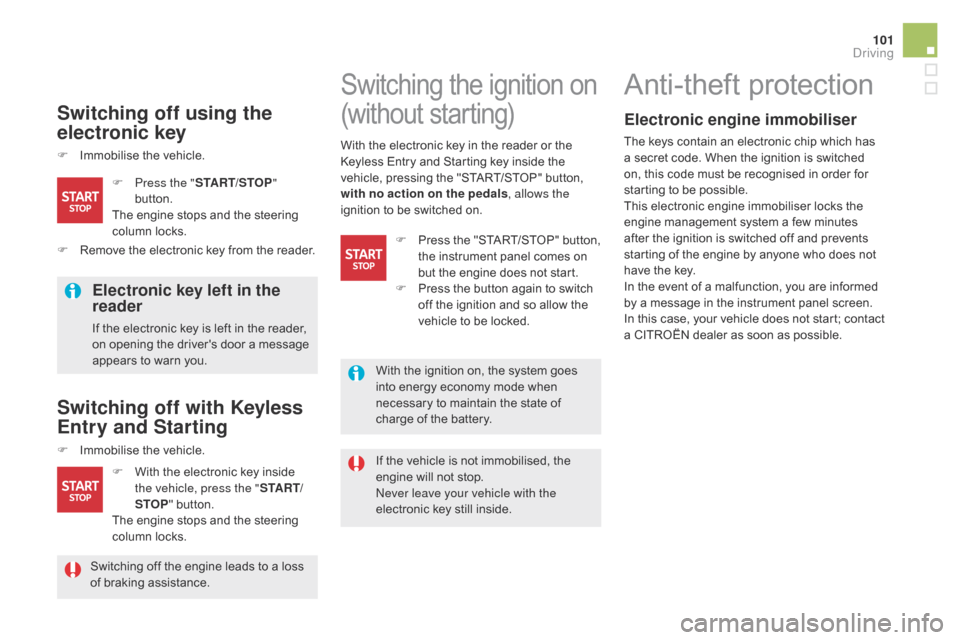
101
DS5_en_Chap04_conduite_ed02-2015
Switching off using the
electronic key
F Immobilise the vehicle.
Electronic key left in the
reader
If the electronic key is left in the reader,
on opening the driver's door a message
appears to warn you.
Switching off with Keyless
Entry and Starting
F Immobilise the vehicle.I f the vehicle is not immobilised, the
engine will not stop.
Never leave your vehicle with the
electronic key still inside.
Switching the ignition on
(without starting)
F With the electronic key inside
t he vehicle, press the " S TA R T/
STOP " button.
The engine stops and the steering
column locks. F
Pr
ess the "
START/STOP "
button.
The engine stops and the steering
column locks.
Anti-theft protection
Electronic engine immobiliser
The keys contain an electronic chip which has
a secret code. When the ignition is switched
on, this code must be recognised in order for
starting to be possible.
This electronic engine immobiliser locks the
engine management system a few minutes
after the ignition is switched off and prevents
starting of the engine by anyone who does not
have the key.
In the event of a malfunction, you are informed
by a message in the instrument panel screen.
In this case, your vehicle does not start; contact
a CITROËN dealer as soon as possible.
With the electronic key in the reader or the
Keyless Entry and Starting key inside the
vehicle, pressing the "START/STOP" button,
with no action on the pedals
, allows the
ignition to be switched on.
F
Re
move the electronic key from the reader. F
Pr
ess the "START/STOP" button,
the instrument panel comes on
but the engine does not start.
F
Pr
ess the button again to switch
off the ignition and so allow the
vehicle to be locked.
With the ignition on, the system goes
into energy economy mode when
necessary to maintain the state of
charge of the battery.
Switching off the engine leads to a loss
of braking assistance.
driving
Page 104 of 500
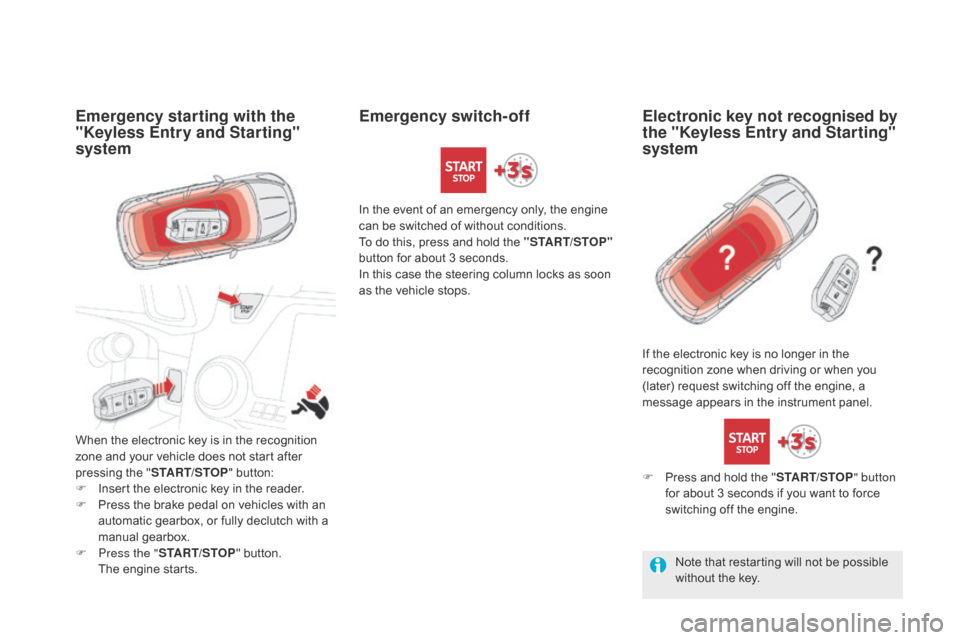
DS5_en_Chap04_conduite_ed02-2015
Emergency starting with the
"Keyless Entry and Starting"
system
When the electronic key is in the recognition
zone and your vehicle does not start after
pressing the "START/STOP " button:
F
In
sert the electronic key in the reader.
F
Pr
ess the brake pedal on vehicles with an
automatic gearbox, or fully declutch with a
manual gearbox.
F
Pr
ess the " START/STOP " button.
Th
e engine starts. In the event of an emergency only, the engine
can be switched of without conditions.
To do this, press and hold the "START/STOP"
button for about 3 seconds.
In this case the steering column locks as soon
as the vehicle stops.
If the electronic key is no longer in the
recognition zone when driving or when you
(later) request switching off the engine, a
message appears in the instrument panel.
Emergency switch-offElectronic key not recognised by
the "Keyless Entry and Starting"
system
F Press and hold the "ST ART/STOP" button
for about 3 seconds if you want to force
switching off the engine.
Note that restarting will not be possible
without the key.
Page 105 of 500
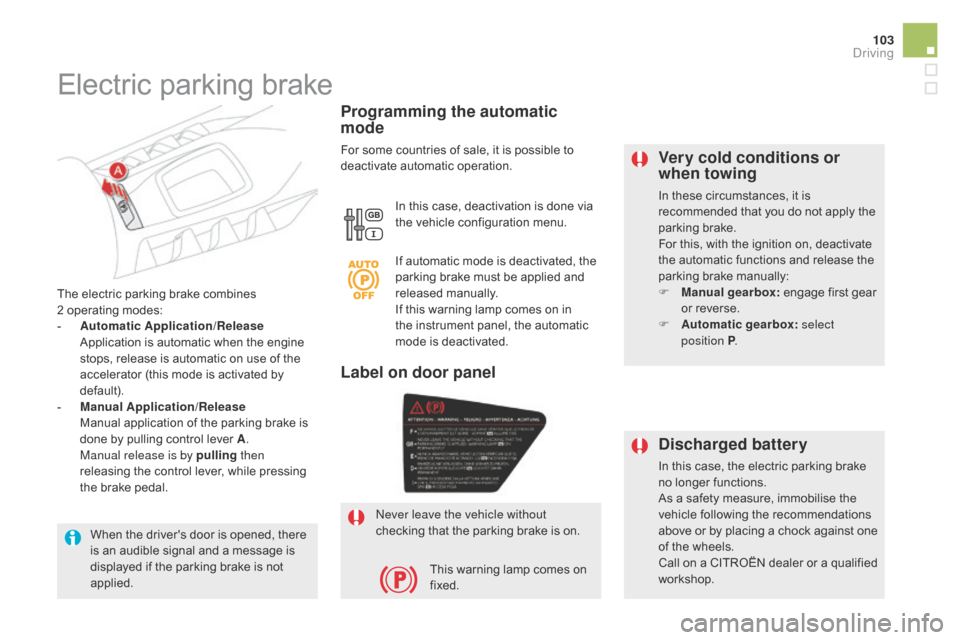
103
DS5_en_Chap04_conduite_ed02-2015
very cold conditions or
wh en towing
In these circumstances, it is
recommended that you do not apply the
parking brake.
For this, with the ignition on, deactivate
the automatic functions and release the
parking brake manually:
F
Ma
nual gearbox: engage first gear
or reverse.
F
Au
tomatic gearbox: select
position P .
The electric parking brake combines
2
o
perating modes:
-
Au
tomatic Application/Release
Ap
plication is automatic when the engine
stops, release is automatic on use of the
accelerator (this mode is activated by
default).
-
Ma
nual Application/Release
Ma
nual application of the parking brake is
done by pulling control lever A .
Ma
nual release is by pulling then
releasing the control lever, while pressing
the brake pedal.
Programming the automatic
mode
For some countries of sale, it is possible to
deactivate automatic operation.
In this case, deactivation is done via
the vehicle configuration menu.
Electric parking brake
If automatic mode is deactivated, the
parking brake must be applied and
released manually.
If this warning lamp comes on in
the instrument panel, the automatic
mode is deactivated.
Never leave the vehicle without
checking that the parking brake is on. This warning lamp comes on
fixed.
Label on door panel
dis
charged battery
In this case, the electric parking brake
no longer functions.
As a safety measure, immobilise the
vehicle following the recommendations
above or by placing a chock against one
of the wheels.
Call on a CITROËN dealer or a qualified
workshop.
When the driver's door is opened, there
is an audible signal and a message is
displayed if the parking brake is not
applied.
driving
Page 106 of 500

DS5_en_Chap04_conduite_ed02-2015
With the ignition on or the engine running, to
release the parking brake, press the brake
pedal , pull then release control lever A .
The full release of the parking brake is
confirmed by:
Manual release
- the braking warning lamp and
t he P warning lamp in the control
lever A going off,
-
di
splay of the message "Parking
brake off ".
If you pull the control lever A without pressing
the brake pedal, the parking brake will not
be released and a message appears in the
instrument panel.
Before leaving the vehicle, check that
parking brake warning lamps in the
instrument panel and the control lever A
are on fixed, not flashing.
With the vehicle stationary, to apply the parking
brake whether the engine is running or off, pull
control lever A .
Manual application
The application of the parking brake is
confirmed by:
-
il
lumination of the braking warning
lamp and of the P warning lamp in
the control lever
A ,
- di
splay of the message "Parking
brake on".
With the engine running, when the driver's
door is opened there is an audible signal and a
message is displayed if the parking brake has
not been applied - unless the selector lever is
in position P (Park) in the case of an automatic
gearbox. Maximum application is essential:
-
in t
he case of a vehicle towing a caravan
or a trailer, if the automatic functions are
activated but you are applying the parking
brake manually,
-
wh
en the slope you are parked on may
vary (e.g. on a ferry, on a lorry, during
towing).
If necessary, you can make a maximum
application
of the parking brake. It is obtained
by means of a long pull on control lever A,
until you see the message "Parking brake
applied fully" and an audible signal is heard.
In the case of towing, a loaded vehicle
or parking on a gradient, make a
maximum application of the parking
brake then turn the front wheels
towards the pavement and engage a
gear when you park.
After a maximum application, the
release time will be longer.
Maximum application
Page 107 of 500

105
DS5_en_Chap04_conduite_ed02-2015
Before leaving the vehicle, check that
parking brake warning lamps in the
instrument panel and in the control lever A
are on fixed (not flashing).
Never leave a child alone inside the
vehicle with the ignition on, as they
could release the parking brake.
Automatic application,
engine off
- illumination of the braking warning
lamp and of the P warning lamp in
the control lever A ,
-
di
splay of the message "Parking
brake on".
With the vehicle stationary, the parking brake
is automatically applied when the engine is
switched off
.
The application of the parking brake is
confirmed by:
Automatic release
The electric parking brake releases
automatically and progressively when you
press the accelerator :
F
Ma
nual gearbox : fully depress the clutch
pedal, engage 1
st or reverse gear; press
the accelerator pedal and let up the clutch
pedal until the brake releases.
F
Au
tomatic gearbox : select position
d, M
or R then press the accelerator pedal.
-
th
e braking warning lamp and
the P warning lamp in the control
lever A going off,
-
di
splay of the message "Parking
brake off ".
When stationary, with the engine running, do
not press the accelerator pedal unnecessarily,
as you may release the parking brake.Before leaving the vehicle, check that
parking brake warning lamps in the
instrument panel and the control lever A
are on fixed, not flashing.
With the engine running and the vehicle
stationary, in order to immobilise the vehicle
it is essential to manually
apply the parking
brake by pulling control lever A.
The application of the parking brake is
confirmed by:
-
il
lumination of the braking warning
lamp and of the P warning lamp in
the control lever A ,
-
di
splay of the message "Parking
brake on".
With the engine running, when the driver's
door is opened there is an audible signal and a
message is displayed if the parking brake has
not been applied - unless the selector lever is
in position P (Park) in the case of an automatic
gearbox.
Immobilising the vehicle,
engine running
Full release of the parking brake is confirmed
by:
driving
Page 108 of 500

DS5_en_Chap04_conduite_ed02-2015
Emergency braking
The emergency braking must only be used in
exceptional circumstances.If a failure of the DSC system is signalled
by the illumination of this warning lamp,
then braking stability is not guaranteed.
In this event, stability must be assured
by the driver by repeating alternate "pull-
release" actions on the control lever A
.
In the event of a failure of the main
service brake or in an exceptional
situation (e.g. driver taken ill, under
instruction, etc) a continuous pull
on the control lever A will stop the
vehicle.
The DSC system provides stability when
braking during emergency braking.
If the emergency braking malfunctions, the
message "Parking brake control faulty" will be
displayed.
Special situations
To ensure correct operation, and so
your safety, the number of successive
applications and releases of the parking
brake is limited to eight cycles.
If used excessively, you are alerted by
the message "parking brake faulty" and
a flashing warning lamp. In some circumstances (engine start...),
the parking brake may adjust the level
of application itself. This is normal
operation.
To move your vehicle a few centimetres
without starting the engine, with the
ignition on, press the brake pedal and
release the parking brake by pulling
then releasing the control lever A .
Complete release of the parking brake
is indicated by the warning lamps in the
control lever A and in the instrument
panel going off and by the display of the
message "Parking brake off ".
Page 109 of 500
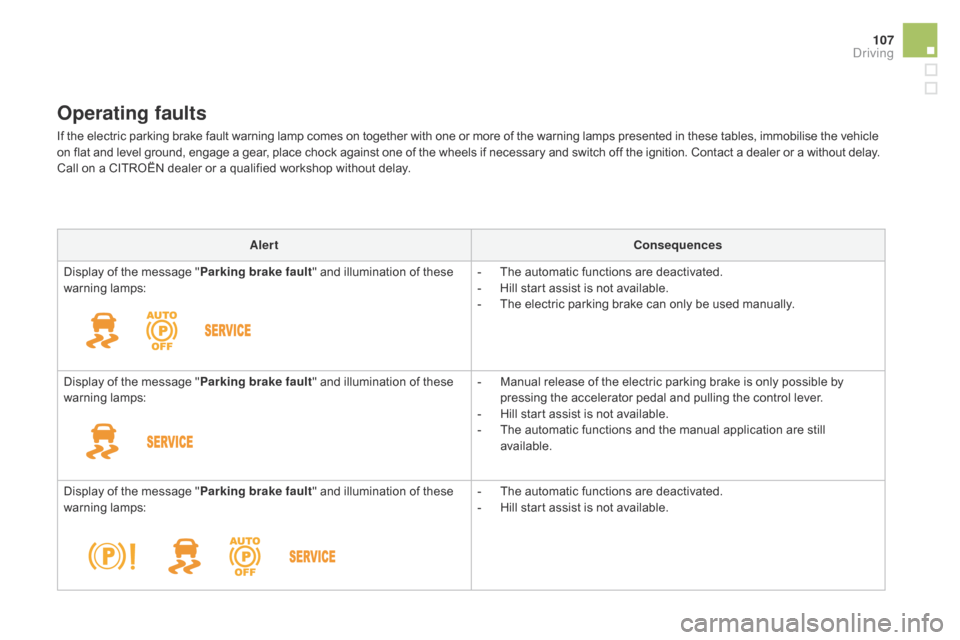
107
DS5_en_Chap04_conduite_ed02-2015
Operating faults
If the electric parking brake fault warning lamp comes on together with one or more of the warning lamps presented in these tables, immobilise the vehicle
on flat and level ground, engage a gear, place chock against one of the wheels if necessary and switch off the ignition. Contact a dealer or a without delay.
Call on a CITROËN dealer or a qualified workshop without delay.Alert
con
sequences
Display of the message " Parking brake fault" and illumination of these
warning lamps: -
Th
e automatic functions are deactivated.
-
Hi
ll start assist is not available.
-
Th
e electric parking brake can only be used manually.
Display of the message " Parking brake fault" and illumination of these
warning lamps: -
Ma
nual release of the electric parking brake is only possible by
pressing the accelerator pedal and pulling the control lever.
-
Hi
ll start assist is not available.
-
Th
e automatic functions and the manual application are still
available.
Display of the message " Parking brake fault" and illumination of these
warning lamps: -
Th
e automatic functions are deactivated.
-
Hi
ll start assist is not available.
driving
Page 110 of 500
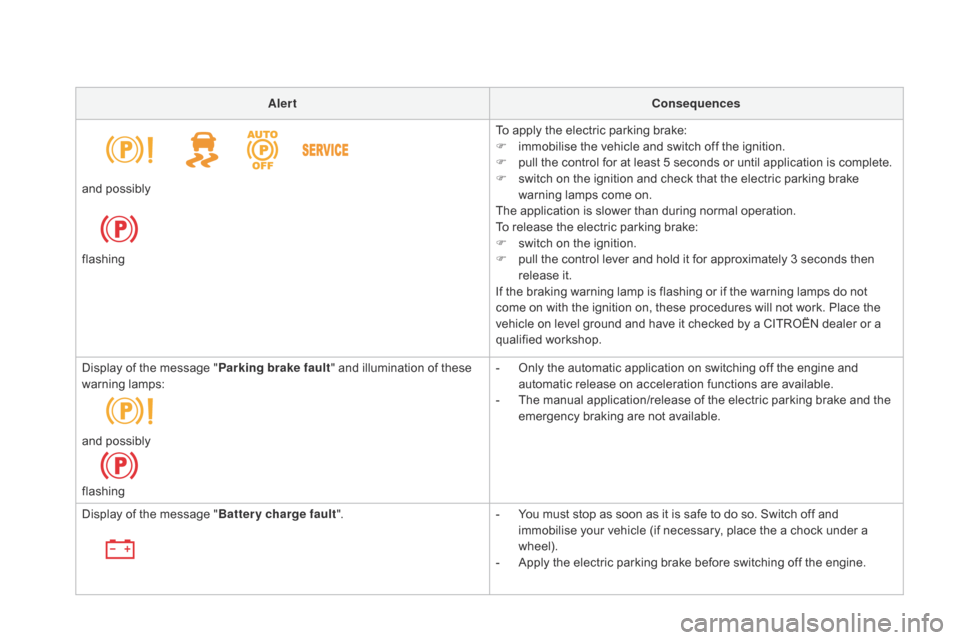
DS5_en_Chap04_conduite_ed02-2015
Alertconsequences
To apply the electric parking brake:
F
im
mobilise the vehicle and switch off the ignition.
F
pu
ll the control for at least 5 seconds or until application is complete.
F
sw
itch on the ignition and check that the electric parking brake
warning lamps come on.
The application is slower than during normal operation.
To release the electric parking brake:
F
sw
itch on the ignition.
F
pu
ll the control lever and hold it for approximately 3 seconds then
release it.
If the braking warning lamp is flashing or if the warning lamps do not
come on with the ignition on, these procedures will not work. Place the
vehicle on level ground and have it checked by a CITROËN dealer or a
qualified workshop.
and possibly
flashing
Display of the message "
Parking brake fault" and illumination of these
warning lamps: -
On
ly the automatic application on switching off the engine and
automatic release on acceleration functions are available.
-
Th
e manual application/release of the electric parking brake and the
emergency braking are not available.
and possibly
flashing
Display of the message " Battery charge fault". -
Yo
u must stop as soon as it is safe to do so. Switch off and
immobilise your vehicle (if necessary, place the a chock under a
wheel).
-
Ap
ply the electric parking brake before switching off the engine.